Hyundai
Veloster Rear Brake Pads Replacement Guide
How to change the rear disc brake pads on
a 1st generation 2012 to 2017 Hyundai Veloster with the part numbers.
By Paul B. Michaels Author & Photographer Auto Mechanic Since 1989 |
||
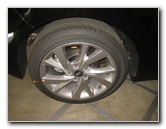 2017 Veloster Rear Wheel |
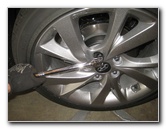 Slightly Loosen Lug Nuts |
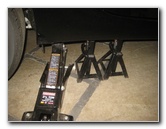 Raise Rear of Car |
| This
automotive maintenance tutorial was specifically written to assist
owners of the first generation (2012, 2013, 2014, 2015, 2016 and
2017) Hyundai Veloster in changing the rear disc brake pads and
lubricating the caliper slider pins. Owners of other Hyundai or Kia vehicles such as the Elantra, Sonata, Azera, Santa Fe, Tucson, Accent, Ioniq, Genesis, Tiburon, ix20, i20, i30, i40, Veracruz, Optima, Cadenza, K900, Soul, Niro, Sportage, Sorento, Sedona, Rio, Forte and Spectra may also find these DIY instructions to be helpful. A few compatible replacement sets of new rear brake pads with their part numbers are as follows: Wagner QC1594, ACDelco 17D1544CH, Bosch BC1594, TRW TPC1594, Monroe GX1594, Power Stop 16-1594 and KFE KFE1594-104. The tools and other items needed to complete this procedure include a lug nut wrench, a floor jack, two jack stands, a 14mm socket, a 3/8" drive ratchet, a 17mm wrench, a pair of needle nose pliers and a tube of brake caliper grease. |
||
|
|
||
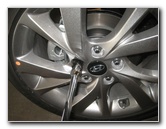 Spin Off Five Lug Nuts |
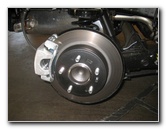 Caliper, Bracket & Rotor |
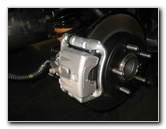 Rear Brake Caliper |
| The first few steps
are to park the car on a level surface, place the transmission in park and
turn off the ignition. Make sure that the emergency / parking brake is NOT engaged. If the parking brake is not released, you will not be able to pull the caliper off the old pads. Place wheel chocks on both sides of the front wheels to prevent the car from moving. Slightly loosen the five lug nuts on the rear wheel by turning them 1/4 to 1/3 turn in the counterclockwise direction with the tire iron. Carefully raise the rear of the car with the floor jack and securely support it with at least two jack stands. I prefer to work on only one side of the car at a time to keep three tires on the ground for extra safety. Spin off the five lug nuts and set them aside in a safe place. Pull off the rear wheel to reveal the caliper, bracket, rotor and suspension. The rear brake caliper is held in place to the bracket by two bolts on the back side of the caliper. The bolt heads face in towards the center of the car. |
||
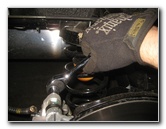 Loosen Top Caliper Bolt |
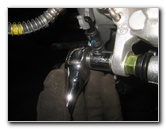 Parking Brake in the Way |
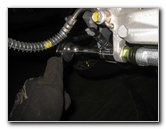 Extension Bar - Bottom Bolt |
| Loosen the top
caliper bolt by turning it clockwise (as seen from the outside of the
vehicle) with the 14mm socket and a 3/8" drive ratchet. I had trouble fitting my 14mm socket and ratchet over the lower caliper bolt due to the parking brake mechanism being in the way. You can either use a short extension on your ratchet or use a 14mm wrench to loosen the lower bolt. Loosen the bottom caliper bolt by turning it clockwise (as seen from the outside of the car) with the 14mm wrench or 14mm socket and ratchet. |
||
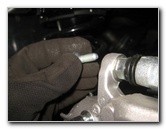 Spin Out Top Caliper Bolt |
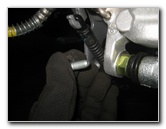 Remove Bottom Caliper Bolt |
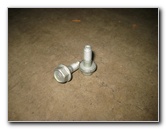 Two Caliper Bolts Removed |
| Spin out the two caliper bolts and set them aside in a safe place. | ||
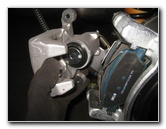 Lift Off Brake Caliper |
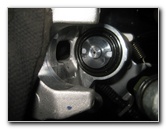 Screw In Type Piston |
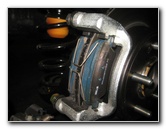 Metal "U"/"V" Spring Clips |
| Carefully lift the
caliper off the old brake pads and out of the bracket. Try to avoid bending, kinking or stressing the rubber brake fluid line. The rear brake calipers are equipped with "screw in" type pistons that need to be rotated or "turned" back to retract them. |
||
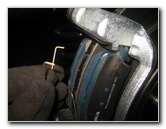 Remove Spring Clips |
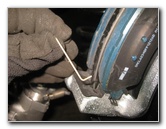 Bottom Clip Removed |
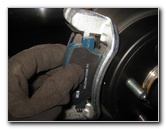 Remove Old Outer Pad |
| Remove the two
metal "V" or "U" shaped spring clips from the outer edge of the old brake
pads. If your set of new rear brake pads did not include replacement spring clips, save the old ones for re-installation later on. Set the two spring clips aside in a safe place. Remove the old outer brake pad from the bracket. |
||
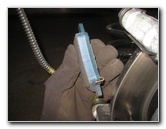 Wear Bar - Bottom Inner Pad |
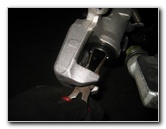 Retract Caliper Piston |
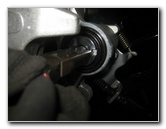 Turn Back Clockwise |
| Remove the old
inner brake pad from the bracket. Make a mental note of where the wear indicator bar or "squeal" bar is situated on the old brake pads. On this 2017 Veloster, the wear indicator bar was located at the bottom of the inner brake pad. Instead of buying a set of caliper piston tools to "wind back" the piston, I've found it easy enough to just use a pair of needle nose pliers. Insert the two prongs of the needle nose pliers in to the two recessed sections of the caliper piston. Gently turn the caliper piston in the clockwise direction to retract it back in to the housing until it is flush with the rubber dust boot surrounding it. Try to avoid scratching or damaging the rubber dust boot surrounding the caliper piston with the needle nose pliers. |
||
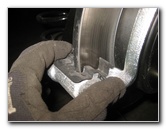 Replace Pad Abutment Clips |
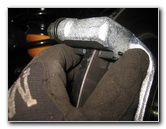 Top "Anti-Rattle" Clip |
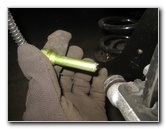 Top Caliper Slider Pin |
| If your new set of
rear brake pads included replacement brake hardware, pull the old pad
abutment clips or "anti-rattle" clips out of the top and bottom of the
bracket. Thoroughly clean off the brake rotor, caliper bracket, lug nut studs and the brake caliper assembly with brake parts cleaner spray. Do not use compressed air or blow with your mouth to clean off the brake parts since inhaling brake dust can be harmful to your health. Brake dust can be carcinogenic (cancer causing) if inhaled. If your Veloster previously exhibited shuddering, pulsating, or vibrations in the rear end during braking, you might need to have your rotors "turned" (resurfaced) or just replace them with brand new rotors. If this is the car's first rear brake job and the rotors appear to be in excellent condition, you should be able to just change the pads with excellent results. To remove the existing rotors and install new ones, remove the two Phillips head set screws on the front of the rotor, remove the two bolts on the rear of the caliper bracket that attach it to the steering knuckle. Remove the bracket and set it aside in a safe place. Then loosen the old rotor with a rubber mallet, pull it off, and slide the new one in its place. Note - The service manual torque specification for tightening the rear bracket bolts is 47 to 54.2 lb-ft (or 63.7 to 73.5 N*m). Apply a thin layer of brake parts lubricant grease to the caliper bracket and the new pad abutment clips where they will come in contact with each other and the new brake pads. In order for the brake caliper to operate smoothly, the two caliper slider pins or "guide bolts" need to be well lubricated. Pull the two caliper slider pins out of their rubber dust boots attached to the bracket. |
||
|
|
||
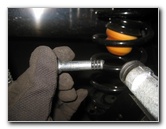 Lubricate & Replace Pins |
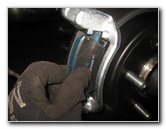 Install New Outer Pad |
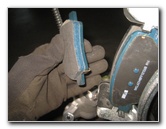 Wear Bar - Bottom Inner Pad |
| Do not mix up the
top and bottom caliper slider pins. They are slightly different. On this
2017 Veloster, the gold/yellow colored pin was located at the bottom and the
silver pin with 3 dark ridges at the end was located at the top of the
caliper. Apply a thin layer of brake parts lubricant grease to the smooth parts of each caliper slider pin before pushing them back in to their rubber dust boots. I recommend buying the Wagner ThermoQuiet QC1594 rear brake pads since they have great reviews on Amazon. Install the new inner and outer brake pads in to the caliper bracket. The wear indicator bar should be located at the bottom of the inner brake pad. |
||
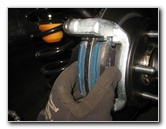 Push Pads Against Rotor |
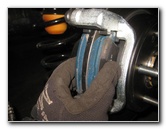 |
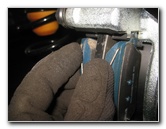 Install Top Spring Clip |
| Push the two pads
together until they are flush against the rotor. Re-attach the two metal spring clips to the outer edge of the new brake pads. (If your new brake pads don't have the holes for the metal spring clips, don't worry about it. Many cars don't have spring clips on the brake pads. Their purpose is to help the pads retract away from the rotor when not braking.) |
||
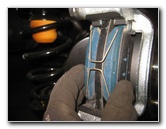 Spring Clips Re-Installed |
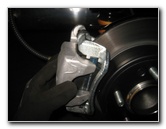 Lower Caliper Over Pads |
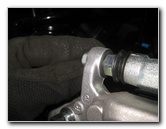 Spin In Top Caliper Bolt |
| Carefully lower the
caliper over the new pads and in to the bracket. Line up the bolt holes in the caliper with their corresponding holes in the slider pins within the bracket. |
||
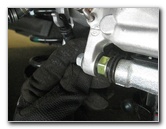 Replace Bottom Caliper Bolt |
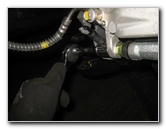 Tighten Bottom Bolt |
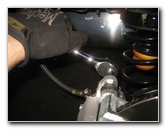 Tighten Top Bolt |
| Spin in the two
caliper bolts a few turns by hand in the counterclockwise direction (as seen
from the outside of the car) to help prevent them from becoming cross
threaded. Tighten the two caliper bolts to just past hand tight or about 20 to 25 lb-ft of torque. Note - The service manual's torque specification for the rear caliper bolts is 15.9 to 23.1 lb-ft (or 21.6 to 31.4 N*m). If the caliper slider pins spin as you are attempting to tighten the caliper bolts, hold them in place with a 17mm wrench. Double check that the two bolts are tight before moving on to the next steps. |
||
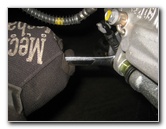 |
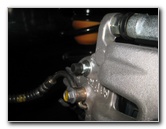 Rubber Valve Cap |
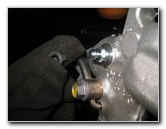 Brake Fluid Bleeder Valve |
|
If your brake pedal has been feeling soft or spongy, the brake fluid may be contaminated with water or the brake lines may contain some air bubbles. It would be best to bleed the brake lines at this time in order to flush out the old fluid and replace it with new DOT 3 or DOT 4 brake fluid. For more on this topic, check out my Brake Line Fluid Bleeding With An Assistant DIY Guide or alternatively the Brake Line Fluid Bleeding With A Power Bleeder Guide. The brake fluid bleeder valve is covered by a rubber cap and located near the center of the caliper. |
||
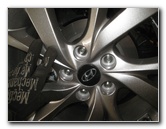 Replace Rear Wheel |
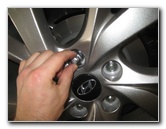 Spin On 5 Lug Nuts |
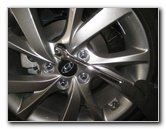 Slightly Tighten Lug Nuts |
| Replace the rear
wheel and spin on the five lug nuts in the clockwise direction a few turns
by hand to prevent them from becoming cross threaded. Slightly tighten the five lug nuts in the clockwise direction in a star or criss cross pattern. |
||
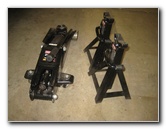 Lower Car From Stands |
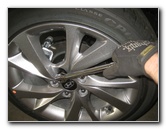 Torque Lug Nuts |
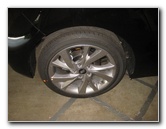 Rear Brake Pads Replaced |
| Carefully lower the
rear of the car from the jack stands by using the floor jack. Continue progressively tightening the lug nuts in a "criss cross" or "star" pattern to about 1/4 to 1/3 turn past hand tight or about 80 lb-ft of torque. The owner's manual torque specification for tightening the the lug nuts is 65 to 79 lb-ft (or 88.3 to 107.9 N*m). It would be best to use a torque wrench or an impact wrench with an 80 lb-ft torque stick to properly tighten the lug nuts. Sit in the driver's seat of the car and firmly push down the brake pedal a few times to restore the brake line pressure. Check the brake fluid in the reservoir and verify that it is at the proper level. If it is low, add some fresh DOT 3 or DOT 4 fluid. To break in your new rear brake pads, just drive normally for the first several hundred miles while trying to avoid any hard or "panic" stops which may glaze over the new pads and cause them to be noisy and not perform as well. It's also a good idea to regularly check your driveway for drops of brake fluid which may indicate a leak, check the brake fluid level in the reservoir, and also verify that the lug nuts are still tight. Be sure to record the brake pad change in your car's service records. For more,
check out all of my
2012-2017 Hyundai Veloster DIY Repair & Maintenance Guides. |
||
| If you found this guide to be helpful,
please consider making a small donation by clicking on the PayPal.com
"Donate" button located to the right of this paragraph. Thank you!
(Note: I am not a registered charity. Donations are not tax deductible.) |

